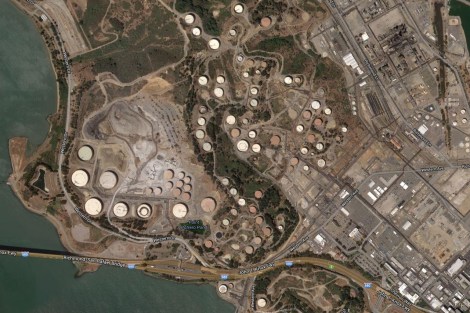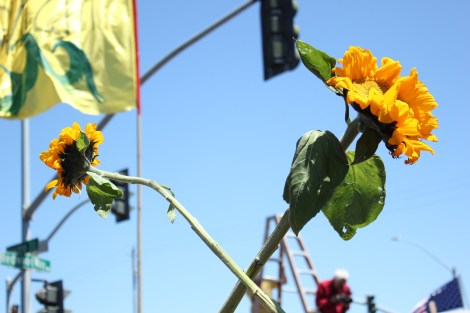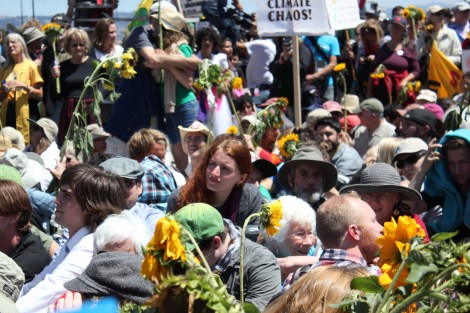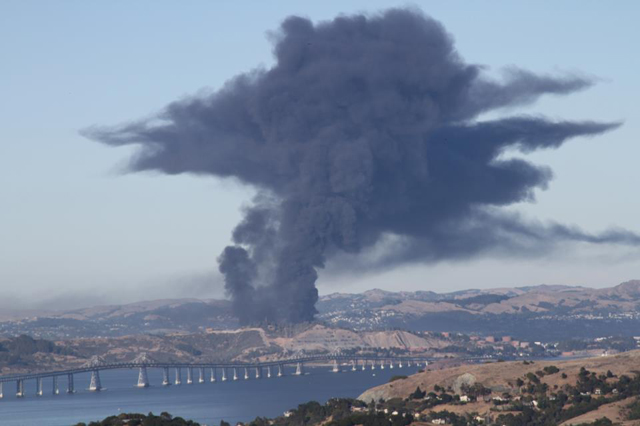After the refinery exploded again last year, Doria Robinson set about tearing out the gardens. Six months of organic planting were lost in one large plume of toxic smoke bellowing from the Chevron refinery in Richmond, Calif., one year ago today, that sent upwards of 15,000 people to local hospitals complaining of respiratory distress.

“They didn’t pay for anything they did to our gardens. Nothing,” she said. “And we lost so much.”
Robinson is the executive director at Urban Tilth, a Richmond nonprofit dedicated to cultivating organic urban agriculture in western Contra Costa County, on the east side of the San Francisco Bay. The incident last August was the third large Chevron fire that Robinson, a third-generation Richmond resident, had experienced in her life.
“I could see the flame from the front porch over 10 blocks away,” she said. “It was absolutely devastating. But it made us actually open our eyes even further to the need to stand up as Richmond residents, on the front line, to Chevron. We need to be standing up in creative ways to stop this madness — not just locally, but internationally.”
Over the weekend, Bay Area residents marked the one-year anniversary of that explosion with a march and rally of about 2,500 people at the gates of the Chevron refinery, one of California state’s top polluters. As a part of 350.org’s “Summer Heat” campaign, the action was aimed at pressuring Chevron to improve its environmental and safety practices, while also promoting other climate fights, such as the battle against the Keystone XL tar-sands pipeline. Chevron is currently pursuing a plan to upgrade its Richmond facility to refine more crude forms of oil, including tar sands.
Local media heralded the weekend protests, which resulted in 200+ arrests for trespassing at Chevron’s gates, as yet another sign of the growing climate justice movement in this country. But this city has been fighting the refinery for a very long time. In this economically depressed community of color, the threat of another plume of toxic smoke in the sky is far more immediate than a Keystone XL pipeline in Texas.

With a population of just over 100,000, Richmond is the largest city in the country with a Green Party mayor. Progressive political programs are gaining popularity, from local “ban-the-box” legislation to experimental community-based violence interruption and a pioneering effort to save foreclosed homes through exercising fierce eminent domain. And last Friday, in a unanimous decision by the city council, Richmond filed a lawsuit against Chevron, seeking unspecified damages against the oil giant — not just to compensate for rescue operations and environmental damages from last August’s fire, but for what it calls a pattern of abuse, and a stigma that the refinery has created for Richmond and its people.
“Richmond has been moving forward in a very strong progressive direction in recent years,” Mayor Gayle McLaughlin said at a press conference announcing the lawsuit. “We’ve really been on the cutting edge of environmental initiatives in terms of what the city can do. A fire like the one that happened last August stops us in our tracks.”
Richmond is no longer content to literally absorb the cost of Chevron doing business. As Asian Pacific Environmental Network activist Henry Clark told the crowd gathered at the refinery on Saturday afternoon: “This ain’t no damn company town — this is the people’s town.”

The Chevron refinery in Richmond, Calif.
But Chevron is enmeshed in the fabric of this town. The refinery that sprawls across five square miles of Richmond’s shoreline is actually older than the city itself. Established in 1902, it is one of the most productive refineries in the country, processing more than 250,000 barrels of crude each day. It is far and away the largest employer in the town, though many of those employees don’t actually reside in the city. About a third of Richmond’s general fund comes from taxes and fees from the refinery.
Disputes between Chevron and Richmond date back decades. Local environmental justice networks blocked a refinery expansion plan in 2009, and the city and oil giant have sparred over millions of dollars in property taxes with a series of competing lawsuits. But the Aug. 6 fire opened a new chapter in this story.
The fire was sparked by a burst pipe that had been thinned by corrosion from the cruder fuels the refinery is pumping. It was potentially made worse by the fact that the refinery continued to operate for two hours after the leak was discovered and workers debated what to do about it. The incident prompted the California division of Occupational Safety and Health to slap Chevron with the maximum allowable fine — the largest in state history — for 11 willful violations. The agency found that Chevron disregarded obvious hazards: The company itself had even recommended replacing the burst pipe back in 2002.
This week, Chevron plead no-contest to six misdemeanor charges stemming from that fire regarding labor standards and negligent discharge of pollutants. The company will pay a fine of $1.28 million, another $575,000 in compensation to agencies that responded to and investigated the incident, plus a $145,000 contribution to a local job training program. The company is also paying out tens of thousands of medical claims to locals sickened by the fire, totaling in the millions. Another $145,600 in air quality fines levied earlier this year was just another drop in the bucket.
In response to the plea deal, Chevron’s spokesperson said in a statement that the company is “committed to continuous improvement in process safety and reliability at the refinery.” But the plea deal and charges were arranged simultaneously; Chevron has essentially bought itself some relatively cheap pardons. In 2012, the company was second only to Exxon Mobil in top U.S. profits, raking in $26.2 billion.
Ironically, the fire also took a huge bite out of property assessments for the refinery and other Richmond land and buildings. Like another black cloud over the city, the Richmond city manager estimates the new assessed values could end up costing the city $6.1 million in lost tax revenues.
Lost property taxes and airborne contaminants aren’t Chevron’s only way of reaching out into the community. The company often makes donations to local nonprofits and programs, say locals, so long as events such as community plantings and anti-violence walks are branded “Chevron.”
Last fall, the oil giant pumped $1.2 million into city elections — nearly $30 for each registered voter, of which nearly 71 percent are Democrats. Local progressives say that money cost them two seats on the city council, which ended up going to Chevron-friendly candidates. The election before that, Chevron spent $1 million.
“They have been polluting our democracy along with polluting our environment,” said McLaughlin. As a result, she said, the city council until recently was unable to muster a majority willing to take action against Chevron. But the recent unanimous vote to sue the company is evidence that the tide has turned.
Eduardo Martinez lost a bid for the Richmond city council in 2012 by 500 votes, after Chevron poured nearly $150,000 directly into negative campaigning. Martinez, a former elementary school teacher, has lived in Richmond for nearly 20 years, and has seen firsthand some of the most disturbing effects the refinery has had on the city. “The pollution from Chevron has affected the community to the point that the asthma was so bad that the parents formed an ‘asthma club’ to attend to the needs of the students who could not participate in physical education programs,” he told me.
As Saturday’s march moved through Richmond’s rough Iron Triangle neighborhood, past empty, locked storefronts and large public housing projects, residents came outside to see what was up. When I told one young man, Wes, where the march was going, he literally jumped: “That thing spills like every year!” Wes lives in the last apartment in a row of housing just across the street and a set of railroad tracks from the refinery. “Everyone I know gets sick all the time here,” he told me.
Many of the health and pollution claims against Chevron are difficult if not impossible to verify and assess, because of a lack of quantifiable data about just how dirty this place is.
“After the fallout from this fire, one of the things we found out was missing here in Richmond is independent soil and air testing that could establish baseline, so we can say, ‘Yes, absolutely Chevron, you are polluting our soil, our air,'” says Doria Robinson. “We don’t have baseline (data) after 100 years of them being here. It’s crazy.”
In a 2010 deal with the city, Chevron agreed to install air quality monitors, but they are still not working, and even if they were, the Bay Area Air Quality Management District can’t accept the type of data those monitors create. Regardless, say advocates, why would we trust Chevron’s data anyway?
“How can you have the entity you’re trying to police, police itself, on an issue that’s so important?” Robinson asked.
Robinson is now working with the mayor and city manager to institute regular soil and air testing programs at all of the city’s gardens. They also plan to hire an independent scientist to establish baseline pollution testing within the city, to differentiate between existing pollutants and pollutants potentially emanating from the refinery. “Have us be the canary,” Robinson says of the gardens. “We have the right to be able to grow and eat our own food in our own land, and no corporation should be able to take that away by polluting.”
Despite the health impacts, many are still moving to Richmond, one of the few affordable housing markets left in the region. Graduate student and Richmond Progressive Alliance activist Zak Wear lived about a half mile from the refinery during last summer’s fire — and then he decided to move even closer. Wear now lives nearly as close as you can get: “Literally over the wall is the Chevron refinery,” he told me.
“It was a tough decision,” said Wear. “I thought, OK, I’ll move here, but I need to do something to ensure that myself and other people in my community are better protected from this refinery in the future. It’s kind of a motivating factor to walk out of your house every day and see the refinery there. It’s like, OK, game on.”
At the press conference announcing the city’s lawsuit against Chevron, McLaughlin was clear: This isn’t just about money, it’s also about a culture of abuse. “This suit is a situation of requiring Chevron to be accountable to our community, to the city of Richmond, and to make the corporate culture shift that is needed to put safety as the top priority,” she said.
One day after that lawsuit was filed, the day of the protest, the San Francisco Chronicle featured a full-page ad from Justice for Ecuador, in solidarity with Richmond protesters. Ecuador won a huge settlement against Chevron in 2011 for its environmental misdeeds. Chevron is appealing the decision.
Full-page ad in today’s @sfchronicle from gov’t of #Ecuador: anti #Chevron, solidarity with #Richmond pic.twitter.com/PIsteJyNS1
— kateschatz (@kateschatz) August 4, 2013
They aren’t the only outside agitators, so to speak. Organizer Shoshana Wechsler grew up in Richmond, and now lives in the hills to the east of the city.
“I see my role as trying to really wake the rest of the Bay Area up to the fact that this community is on the front lines. It’s receiving terrible immediate impacts, but all of us are being affected,” she said. “In the Bay Area we tend to be a little smug. ‘We have a great eco track record!’ We don’t think about Chevron or any of the other refineries because they’re in these non-glamorous parts of the Bay Area.”
Those non-glamorous parts add up to make this region one of the top metropolitan areas for oil exports, and a significant contributor to global climate change.
For now, at least, concerns about environmental impacts, public health, and worker safety have brought together a broad coalition of environmental justice advocates, labor unions, politicians, and others to oppose Chevron. The question is whether this alliance will last.
In response to criticism and legal challenges, Chevron is moving to upgrade the refinery to improve safety for workers — and to allow the facility to process a wider array of cruder fuels. Chevron has been attempting to upgrade the refinery since 2005, but the company’s efforts were iced by a state court following a long legal battle against area environmentalists and community advocates. If Chevron’s refinery upgrade plans speak to labor unions’ concerns about frontline worker safety, this coalition might not survive.
On Saturday, though, labor was out in force, with upwards of two dozen individual unions representing. A long march led by Idle No More activists featured massive banners and tall puppets. Marchers burned sage and carried sunflowers, a symbol of environmental justice here in part for their ability to draw toxins out of the soil.

Eco-justice activists Bill McKibben (a Grist board member) and David Solnit were in attendance. But those national figures took a backseat to local organizers and advocates with Communities for a Better Environment, the Richmond Progressive Alliance, the West County Toxics Coalition, Asian Pacific Environmental Network, and others who have been fighting this Chevron refinery for years, and told their stories throughout the day.
Richmond’s population is about 40 percent Latino, and 30 percent black. The less diverse demographics of Saturday’s march were more typical of the larger climate protests we’ve seen recently: Basically, it was mostly white people.
According to Richmond police, 208 people were arrested in a carefully orchestrated and relatively low-impact act of civil disobedience at the gates of Chevron, apparently dominated by out-of-towners. Part of the way through, I asked the crowd of several dozen waiting for their plastic handcuffs: “Who lives in Richmond?” No one replied.
The process took about two very surreal hours. The arrestees were not actually arrested; they were briefly detained on site, and not processed or given citations by the city. Nonetheless, largely because of the large number of “arrests,” the protest received a huge pile of media coverage.

Past actions and protests organized by local environmental justice groups have drawn “basically Richmond people, with a few fellow outside travelers,” said Wechsler. Saturday’s protest was an opportunity to introduce Richmond’s frontline issues to a broader Bay Area coalition of environmentally concerned and active citizens. Richmond advocates report feeling “invigorated” by the weekend to continue their local fight.
“How do we expect Chevron to respond? Frankly we don’t,” Wechsler said, sighing. “It’s really about public awareness.”
Of course the Richmond public is already incredibly aware of Chevron’s impact. That couldn’t have been more clear as I stood with Wes on the front stoop of his apartment as he told me about his friends with asthma, about what the black cloud looked like and smelled like last summer, about what it’s like to live in the shadow of this place.
But while Wes was painfully aware of the day-to-day realities, word of the larger climate movement that had temporarily taken over his town apparently hadn’t reached him. When I told Wes that activists probably wouldn’t be shutting down the refinery, he was disappointed. Still, he said, “This is hella legit. I just wish I’d known about it before. I would’ve been out there with everybody.”



